Inside look: the world around us

Dedicated to one beautiful man ...
Already from the second publication from the series “Inside Look”, the idea came to look under the microscope of simple objects that surround us every day and this resonated with the Habr residents . In addition, Anton Wojciechowski supported this idea, and at the muzzle of an electron microscope a variety of objects were already visited: from flowers to shadows. Therefore, this publication will be far from IT topics, but, firstly, I think it is useful for broadening one's horizons, and secondly, a drop of IT is still contained in it - all this would not have happened without such a rapid development of computer techniques and its applications in electron microscopy.
Under the cut will be a lot of pictures and very little text to clarify what is happening.
This article was published on the Internet blog with the goal of being accessible to the entire Internet ...
Foreword
There is a lot of space down there ...
Richard Feynman, 1959.
All photographs were obtained using a scanning (also called raster) electron microscope from samples without any sample preparation, that is, without spraying a conductive coating on the samples. Therefore, some artifacts may be present in microphotographs. For example, charging provokes distortion of straight sections in the image and does not allow shooting at high magnifications, charged regions are usually lighter, etc. However, in my opinion, such a shooting is much more interesting from the point of view of practice. So for a rose, one could observe the “deflating” of cells damaged by an electron beam, whereas it would not be possible if the sample was “dusted” with gold.
"Bytovuha"
Let's start with a simple and, it seems to me, a little less interesting. They come in different qualities, different colors and designs, but we use them almost every day. Meet the usual napkin:

On the microphotograph, individual fibers are visible that are intertwined with each other and thus form a single mass.
In some ways, cotton wool looks like a napkin, however, the latter consists of “strings”:
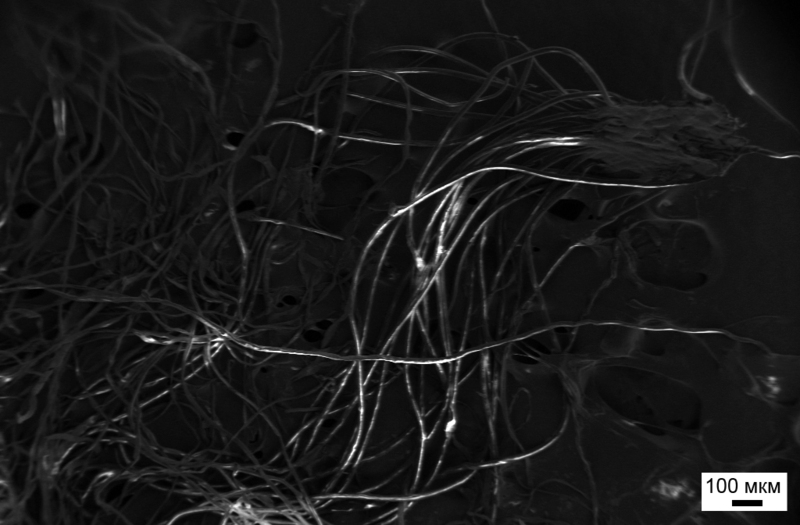
Networks ...
Now it’s a little more complicated - a razor of a well-known manufacturer (I can reveal the brand in the comments so that it doesn’t look like an obvious advertisement):
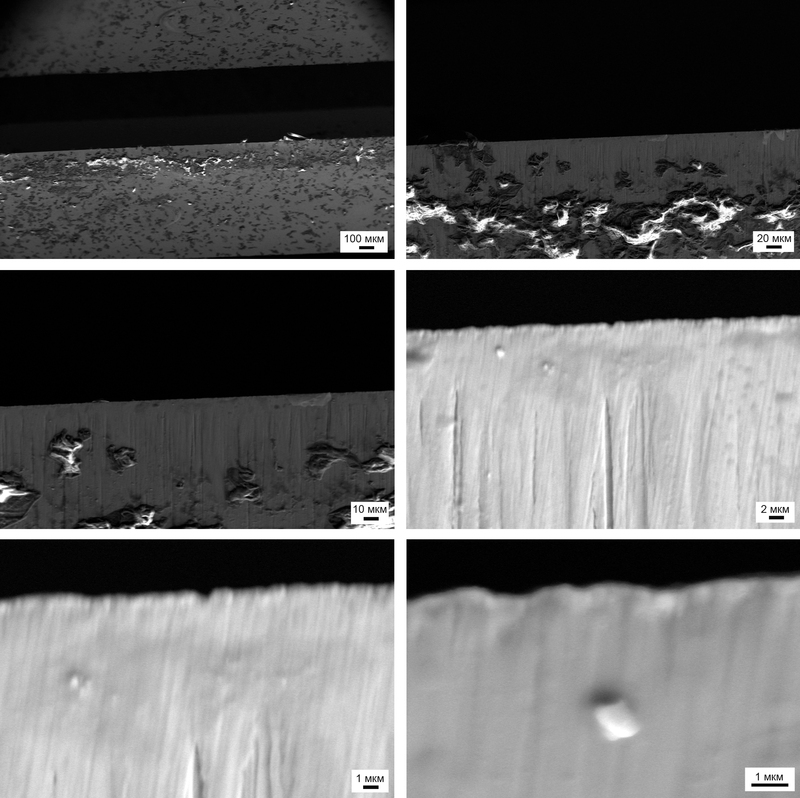
A razor blade and pieces of skin on it ...
Since there was no new blade at that time, the photos were taken from a fairly used machine. In the photographs, skin particles are clearly visible. Yes, dear ladies and gentlemen, this is what accumulates in the form of a light, barely noticeable white coating on your razor (maybe after that everyone will stop shaving ?!). By the way, in the images of the edge of one of the blades, it seems to me, there is a coating. They say that the blade itself is covered with a thin layer of hydrophobic substance, which reduces the coefficient of friction and, accordingly, irritation.
Of course, when scientific and technological progress did not reach our kitchens, many of us, when dealing with gas stoves, used matches. Someone used them for other purposes, for example, burned a match and ate the brackish residue of a match head. But not many imagined that in this way they actually regale themselves with “nanotechnologies” (nanoparticles that form after combustion).

Microphotographs of the match head before (left) and after (right) ignition
I hope that among all of us there are many representatives of the fair half of humanity who often use shadows, often, of course, for the mercenary purposes of attracting the attention of the stronger half. However, I don’t think that the cute girls wondered how it looks at the micro level what they like to put on their face:

Each morning, girls apply such “pancakes” on their face to wash off in the evening
. Meanwhile, the shadows consist of separate scales, with a thickness of 100 nm or more, which is easy to see:

That's all for now with the household part, and now let's move on from the world “ inanimate "objects, into the world of our favorite flowers and animals.
Plants
Someone swallows them along with grapes, someone carefully “catches” them and separates them from the pulp, but perhaps no one saw them from this angle - grape seeds:

The germ inside the grape seed
Inside the kingdom of the seed: huge spherical cells waiting of your time to start sharing, multiplying and, ultimately, turning into a vine with a new bunch of grapes. But for this they need reliable protection in the form of a kind of shell, "shell":

Note that the cells of the shell are rougher: they are stretched perpendicular to the surface of the shell and stick out with sharp corners from the bone, like guards, ready in a favorable set of circumstances to open the way for water inside to give birth new life:
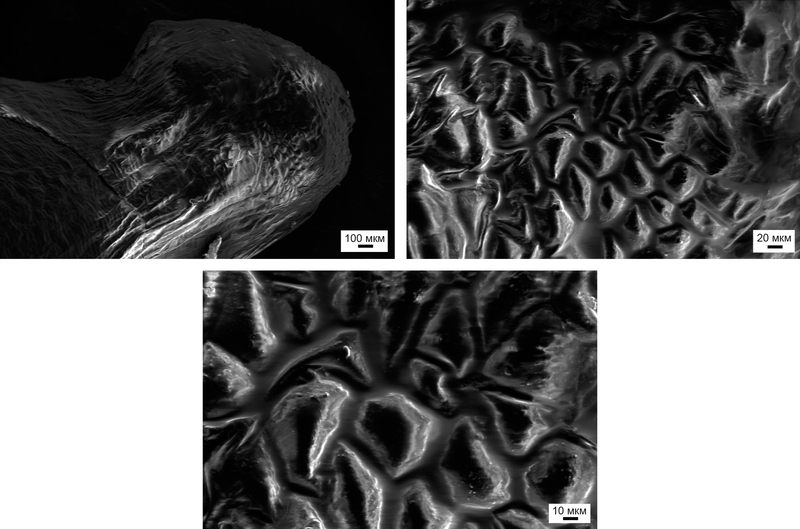
Guardian of a seed enclosed inside a grape seed
Does anyone remember what a violet looks like ?! These are such little blue flowers, slightly shaggy and therefore very, very soft. And all because some cells sprouted up processes

on the surface : A married couple on the surface of a violet flower finds out the relationship ...
And the rest of the surface is countless ordinary cells:
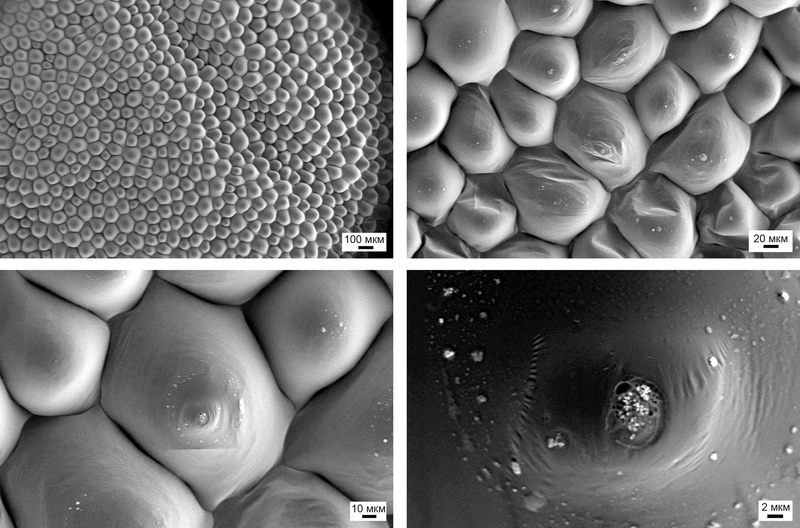
In general, the conditions for organic objects inside the electron microscope are not the best: high vacuum, drying everything without residue , strong electric field and local heating under the electron beam. The latter, by the way, demonstrates well the lower right figure. While I was “guided” (adjusting focus, astigmatism), that is, the electron beam ran many times over the same rather small part of the surface, it hurt the cell ...
Although even without this, due to a combination of factors, biological objects inside an electron microscope do not live for long:

Completely healthy, living (left) and damaged, dying (right) cells
Perhaps it was worth placing these microphotographs somewhere in the beginning, because it was from them, to be exact, from a joke: “And let's shoot a rose!” - all the works presented here began:
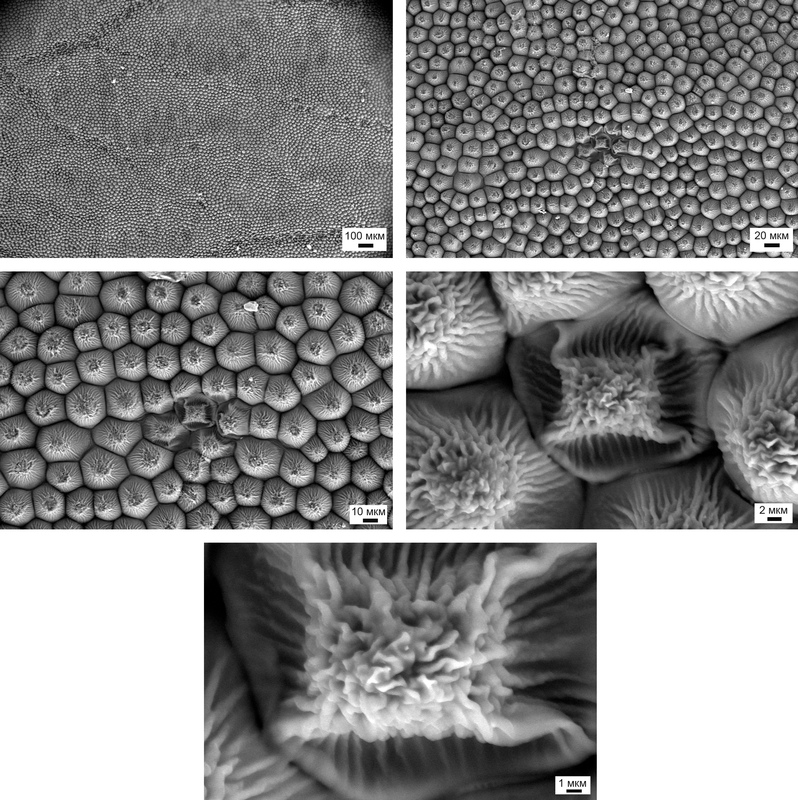
Rose petal: you are looking for answers from the outside, but answers inside ...
The rose is just beautiful. She is a rare example of a combination of internal and external beauty. See how dramatically different the surface of violets and roses. Violets have smooth cells, and roses have rough cells. One interesting property of the rose leaf is associated with this. If a violet (I think because of its adaptability to an alpine and temperate climate) has a flower surface that “collects” water, then a rose repels it, cleansing the surface. And these roughnesses play a key role in this behavior of the rose flower. Air is trapped in folds, creating additional water-air interfaces, making the surface more hydrophobic than it actually is. This phenomenon is called the Lotus effect., which today finds more and more widespread use (for example, self-cleaning paints, car anti-fog glass, etc.).
And here is a gerbera with beautiful large and bright flowers: A
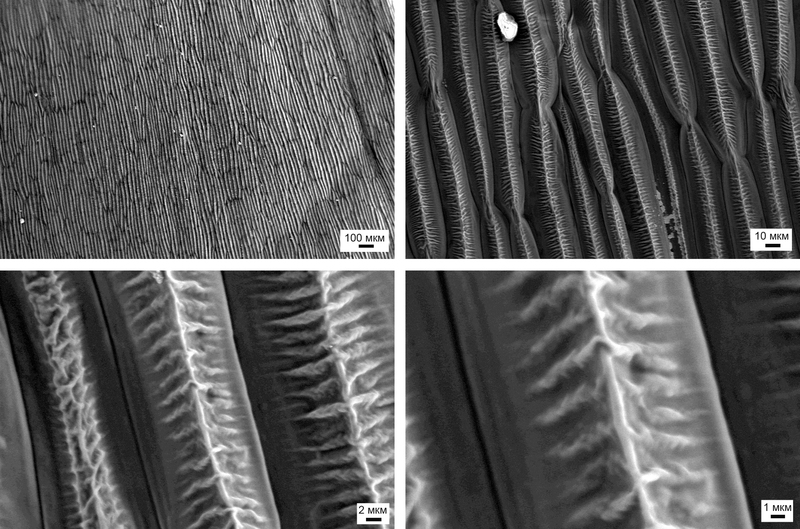
modest and unpretentious gerbera
And inside - modesty itself. Even somehow it’s not interesting to discuss, but let's compare ...
Gerbera with the “winter” aster (I was introduced to it this way, but I think it’s more correct to call it an alpine aster). It seems that the petals of the flowers are similar, and the structure of the flowers is somewhat reminiscent of each other (after all, they belong to the same family), but in fact:
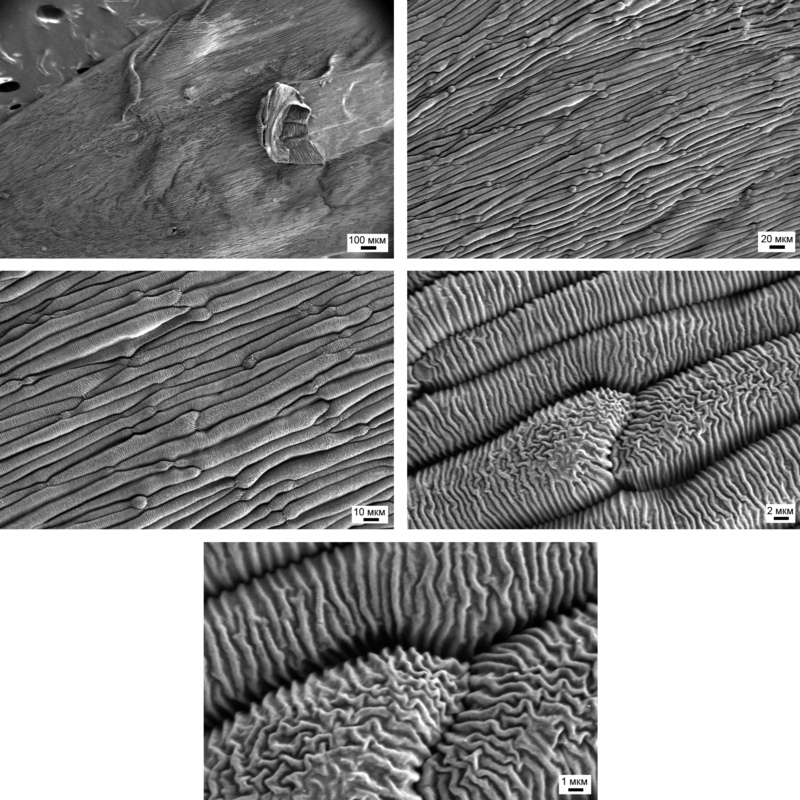
Astra looks more like a rose than its closest relative - a gerbera
The only similarities are oblong cells. I would even say that the aster is more like a rose flower, only the cells are more elongated along the petal itself. In addition, the place of attachment of such a petal to the inflorescence itself looks intriguing:
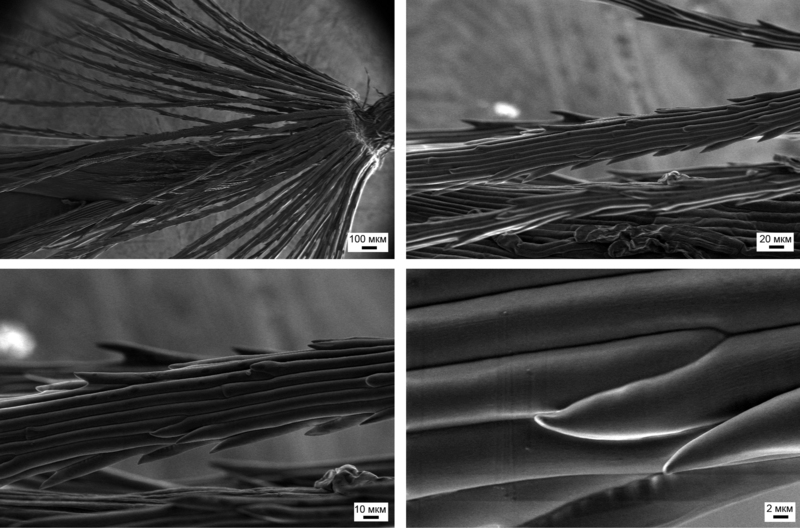
And here there are already smooth cells. Agree, funny ?!
And I think that these “hooks” - the cells protruding from the stems - are given by Nature to this plant for a reason, can anyone come up with why?
The next indoor plant should be loved by the weak half of the audience - spathiphyllum or in the common folk “Feminine happiness”.

It seems to be nothing interesting. But the respiratory pores in the flower are absolutely amazing (nervous and impressionable, as well as children, it is better to miss this moment):
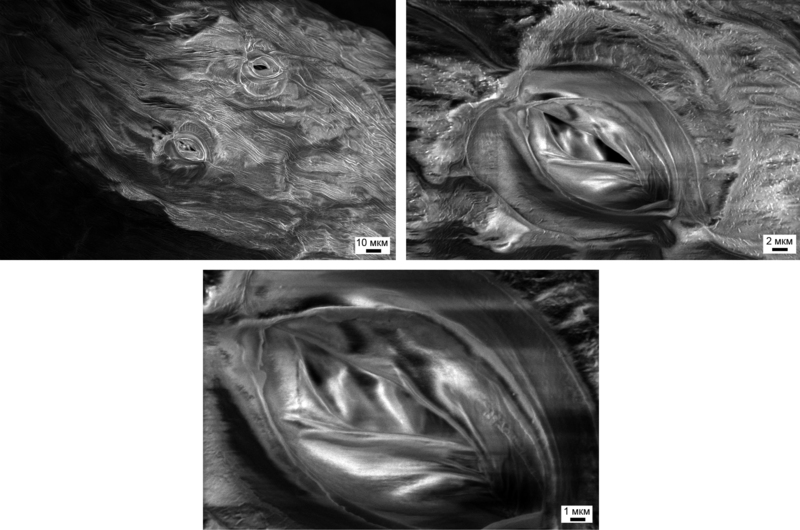
Respiratory pores
Since I took the plant by surprise: it just wanted to drop its flower along with the seeds. By the way, perhaps the debris in the previous images is caused by the death of the flower and the decomposition that has begun, that is, the devouring of the flower by various microorganisms. So, the seeds, or rather the one and only “seed” of the Spathiphyllum
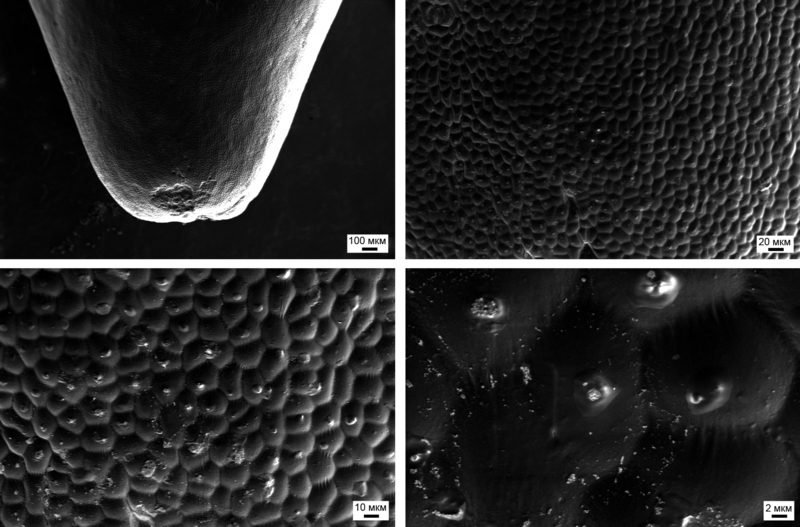
Seed - around the cell
I don’t even know what these small particles found in the place of attachment of the seed to the plant belong to (maybe some pollen residues ?!):
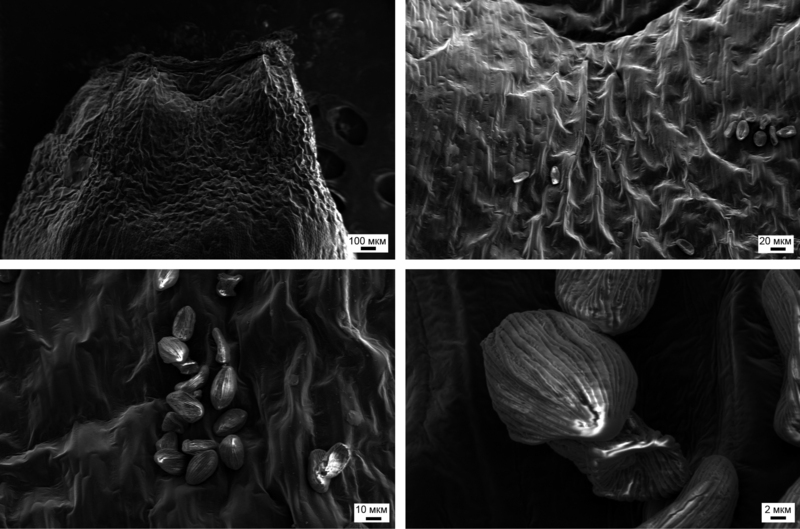
And finally, a little about animals or rather about their outer cover - hair and feathers ...
Animals
Let's start with some triviality - a person’s hairline (had to donate from a beard): The
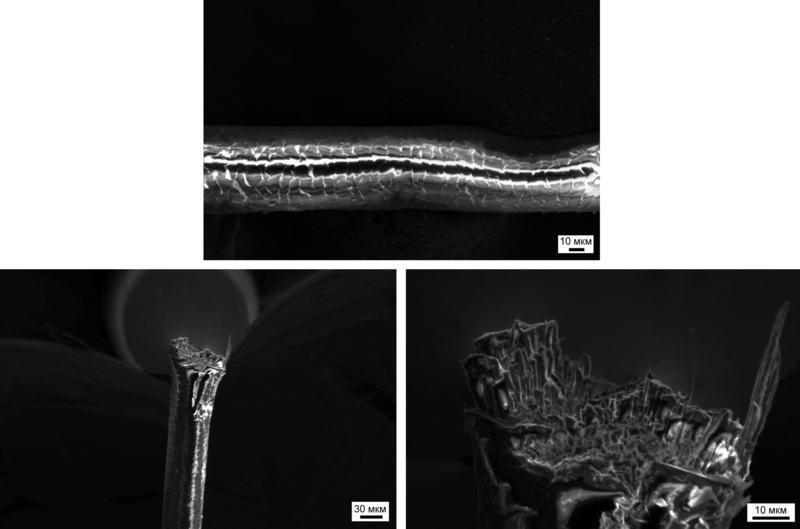
hair didn’t completely fit in the place allotted to him, had to be cut ...
Of course, we all, at least in the advertisement, saw that the hair has a scaly structure (this is good on the top photo visible), but absolutely few saw the hair cut ... One way or another, our hair looks like after going to the hairdresser. If it will be interesting, then about the parts of the human body in color, you can see here - there are many beautiful SEM-micrographs.
A friend of mine decided to have a budgie, and when I came to her to show photographs of a rose, I was immediately presented with a feather, which had just been thrown out of my body by the parrot, either from the wing or from the tail. But this is understandable, pay attention to the number of microorganisms and other nastiness in the down:
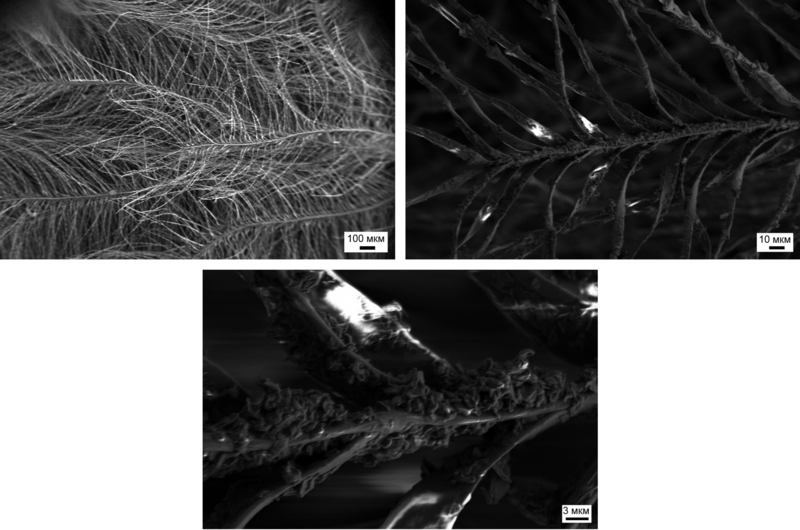
Microphotographs of the budgerigar fluff are closer to the base of the feather
Although the main part of the feather (core) has been preserved in excellent shape. Look how perfectly stacked "hairs" in the pen - it's all for the sake of the birds can fly and maneuver in the air, their wings were not sieve the air, and, of course, this has its own aesthetic function:

The guard of the budgie feather
Well, when one of the researchers at our laboratory at Moscow State University found out about these photos, they gave me a small peacock feather to tear to pieces . Apparently, it once belonged to a young individual, since it was no more than 10-15 cm long.
Let's start, as in the case of the parrot, with the “undercoat” in which microorganisms also live. Unfortunately, at that moment Wojciechowski was not nearby, eager to see the running "green men" on the surface of biological samples. True, they do not run, but simply stick to the hairs of the fluff:
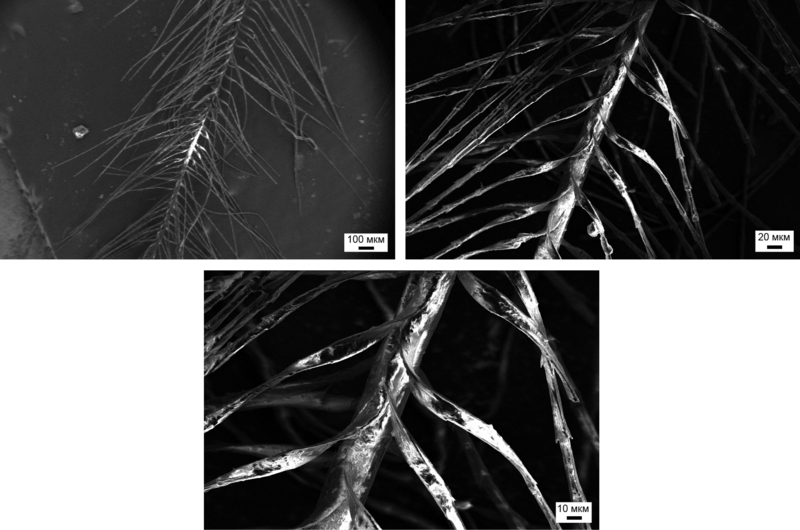
And a little more microphotographs of the fluff, more precisely the part of the hairs that is removed from the core of the feather:
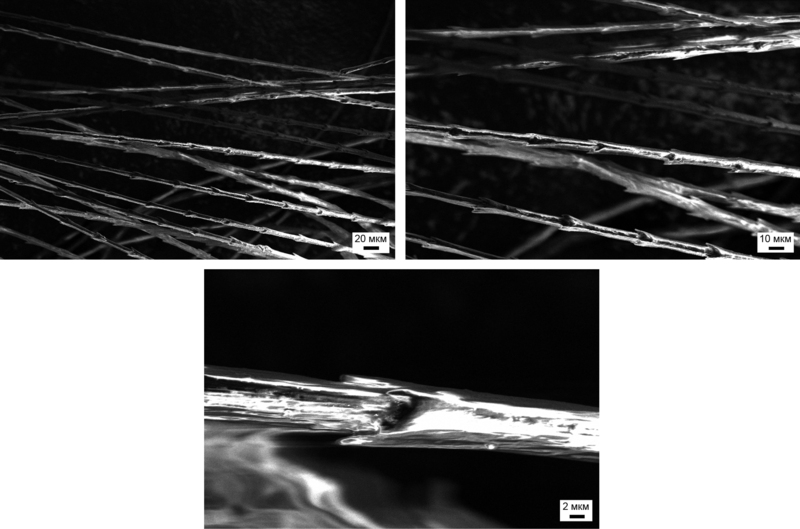
As if the "hairs" are inserted one into the other
The main part of the feather looks like this:
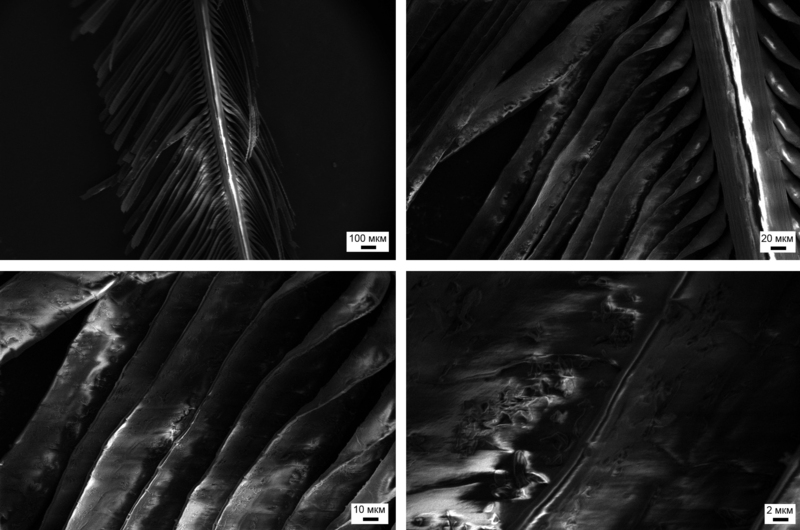
Here, wide flattened “hairs” are overlapped, which ensures the solidity of the pen, lower permeability to air and its beauty, both in battles between males and in relationships with members of the opposite sex.
But that is not all. If we compare with a budgie, in which the hairs are short (about 100 microns in length) and stiff and do not have links with each other, then in the peacock feather these hairs are longer (up to 300-500 microns in length) and, accordingly, less rigid . And so that they would not mess up when wearing such a chic feather costume, Nature came up with the following:
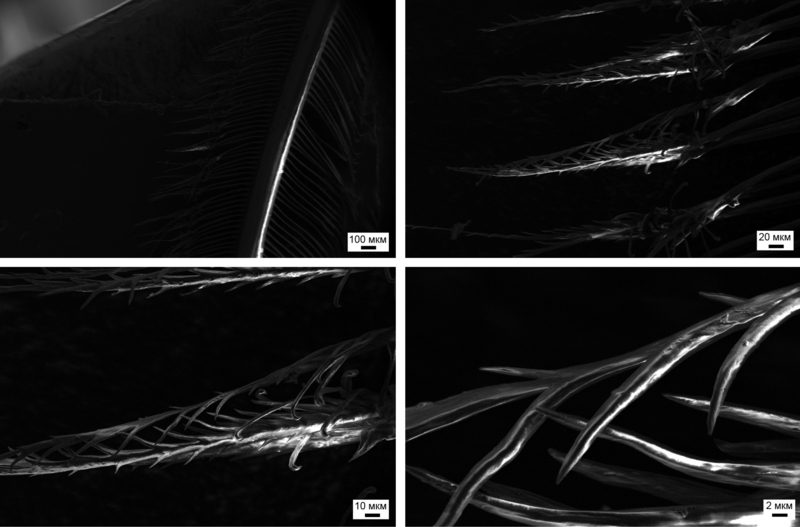
Ancestor zip-lock, created by Nature.
Individual hairs are interlocked at the ends between each other and can also be used to adjoin neighboring feathers using such devices, etc.
Lastly, the hairs inside the feather have an interesting structure with broadening and thinning along one hair. This determines the iridescent coloring, the play of color and the glitter in the sun of a peacock feather:
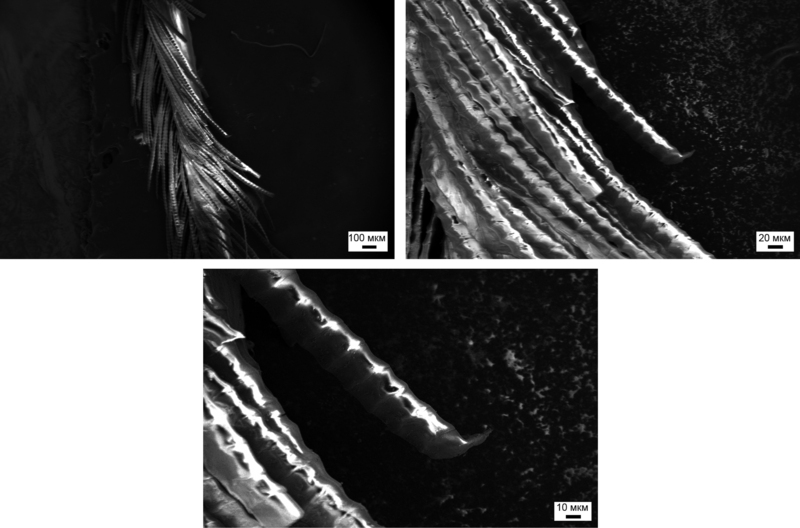
These thickenings of individual hairs are responsible for the play of light of a peacock feather.
More about the structure of feathers can be found here .
Afterword
That's all for now. If you have any ideas what could be viewed in an electron microscope, sawed, what else to write on Habré, feel free to send me your wishes in any available way (all contacts are in the profile) or by e-mail smirnovea_ (at) _gmail .com (without the signs "_", and (at) - well, you yourself know ...).
PS: I managed to fasten subtitles for the New Year holidays to the OSRAM video, enjoy it here . And don’t forget to subscribe to the channel , I hope there will soon be a “homegrown” video about plasma in the installation for the deposition of conductive coatings, which was poorly visible in this video ...
PPS: If someone else has not read the previous articles, you can see them here:
Opening the Nvidia 8600M GT chip , a more detailed article is given here: Modern chips - inside view Inside
view: CD and HDD
Inside view: LED bulbs
Inside view: LED industry in Russia
Inside view: Flash memory and RAM
List object for the future
Интересное:
Дисплеи (e-ink, обычный TFT с резистивной матрицей). Если кто-то пожертвует сенсорный ёмкостной или Gorilla Glass, буду премного благодарен…
Разрезать клетку и аккуратно посмотреть на внутренности
В дополнении к спичка — чиркаш
Электролитический конденсатор
Оптоволокно
флоппи-диски, магнитные ленты, виниловые пластинки, фотопленку, киноленту (нужны только сами образцы)
Поверхность слоя scratch-карт или моментальных лотерейных билетов
Поверхность «обычного» полированного пластика (ПВХ, ПП и т.д.) и поверхность пластика, покрытого «soft touch» (опять-таки нужны образцы)
Кромка металлической линейки
Шарик/шарики шариковой ручки
The braid and the inside of the guitar string (you need to take a new and highly used one, but the guitar string in general is here )
meat / fish and other edible things
Radio Frequency Tags (RFID) - just compare the usual RosNanov super-duper tag with some ordinary
Skepticism:
Holographic a sticker (the physical principle of Holography hints that it will be just a monolithic piece of polymer, but as soon as possible - I'll see)
Tap water, beer, other liquids (sterilization kills everyone, but it's easy to see nanoparticles)
The surface and inside of porous materials such as polyethylene foam, polypropylene foam, polyurethane foam, a filter from cigarettes (I even looked at the earplugs with an optical microscope - it wasn’t impressive, but I’ll try to play with an electron microscope)
Already on the Internet:
Dust mites and sperm cells (like discussed in the comments - watch here and here )
First , a complete list of published articles on Habré:
Opening the Nvidia 8600M GT chip , a more detailed article is given here: Modern chips - an inside view Inside
view: CD and HDD
Inside view: LED bulbs
Inside view: LED industry in Russia
Inside view: Flash -memory and RAM
Inside view: the world around us
Inside view: LCD and E-Ink displays
Inside view: digital camera arrays
Inside view: Plastic Logic
Inside view: RFID and other marks
Inside view: graduate school in EPFL. Part 1
Inside Look: Graduate School at EPFL. Part 2
Inside view: the world around us - 2
Inside view: the world around us - 3
Inside view: the world around us - 4
Inside view: 13 LED lamps and a bottle of rum. Part 1
Inside view: 13 LED lamps and a bottle of rum. Part 2
Inside view: 13 LED lamps and a bottle of rum. Part 3
Inside Look: IKEA LED Strikes Back
Inside Look: Are Filament Lamps So Good?
and 3DNews:
Microview: comparing displays of modern smartphones
. Secondly , in addition to the HabraHabr blog , articles and videos can be read and viewed on Nanometer.ru , YouTube , and Dirty .
Thirdlyif you, dear reader, liked the article or you want to stimulate writing new ones, then proceed according to the following maxim: "pay what you want"
Yandex.Money 41001234893231
WebMoney (R296920395341 or Z333281944680)
Sometimes you can read briefly, and sometimes not so much about the news of science and technology on my Telegram channel - we ask you;)
